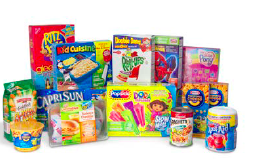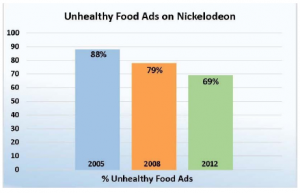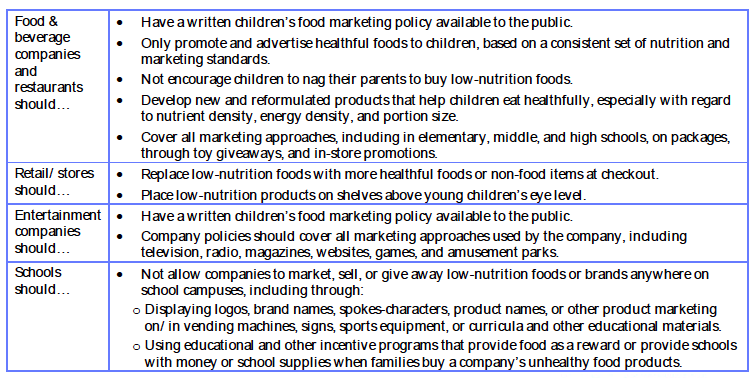Food marketing to children
- Companies market food to children through television, radio, Internet, magazines, product placement in movies and video games, schools, product packages, toys, clothing and other
 merchandise, and almost anywhere a logo or product image can be shown.
merchandise, and almost anywhere a logo or product image can be shown. - Food marketing techniques include the use of spokes-characters, celebrities, cartoons, toy giveaways and other premiums, collectibles, games, contests, kids’ clubs, and more.
- The total amount spent on food marketing to children is about $2 billion a year.1
Food marketing to children works
There is no disputing the fact that the goal of food marketing is to influence children’s food choices.
- Companies clearly believe that marketing works or they wouldn’t spend billions of dollars a year on it.
- According to a comprehensive review by the National Academies’ Institute of Medicine, studies demonstrate that television food advertising affects children’s food choices, food purchase requests, diets, and health.2
- Parents know from experience that ads and cartoon characters on food packages affect not only which foods their children ask them to purchase, but which foods their kids are willing to eat.
- Based on an extensive review of the research, the American Psychological Association concluded that until the age of about 8 years old, children are unable to understand the persuasive intent of advertisements.3
Marketed foods typically are of poor nutritional quality
The overwhelming majority of foods marketed to children are of poor nutritional quality.
- Three-quarters (73%) of the foods advertised on television shows intended for children are for convenience/fast foods and sweets.4

- On Nickelodeon, the most popular children’s television station, ads for foods of poor nutritional quality decreased only modestly from before self-regulation went into effect (2005) to after (2012), from about 90% to 70% of food ads.
- Only one-quarter of chain restaurants that market to children have food marketing policies and none of those address toys. Yet, 97% of children’s meals at the top U.S. restaurant chains are of poor nutritional quality.5
Marketing foods of poor nutritional quality undermines parental authority
Parents bear the primary responsibility for feeding their children, but parents are out-maneuvered by aggressive food marketers.
- Parental authority is undermined by wide discrepancies between what parents tell their child is healthful to eat and what marketing promotes as desirable to eat.
- While many parents have limited nutrition knowledge, companies have extensive expertise in persuasive techniques.
- Companies have resources to influence children’s food choices that parents do not have, like cartoon characters, great music, celebrities, contests, games, and toy give-aways.

Responsible food marketing to children
Food and beverage companies, restaurants, retail stores, schools, broadcasters, and other entertainment companies should market foods responsibly to children. The table below outlines some of the key steps toward responsible marketing to children.

For more information, please contact Kate Klimczak: kklimczak@cspinet.org, (202) 777-8329.
References
1. Federal Trade Commission. A Review of Food Marketing Children and Adolescents: Follow-Up Report. Washington, DC: Federal Trade Commission, 2012.
2. Institute of Medicine. Food Marketing to Children: Threat or Opportunity?Washington, DC: National Academies Press, 2006.
3. Kunkel D. et al. Psychological Issues in the Increasing Commercialization of Childhood: Report of the APA Task Force on Advertising and Children.Washington, DC: American Psychological Association, 2004.
4. Kunkel D. et al. The Impact of Industry Self-Regulation on the Nutritional Quality of Foods Advertised to Children on Television. Oakland, CA: Children Now, 2009.
5. Batada, A., and M. Wootan. Kids’ Meals II: Obesity on the Menu. Washington, D.C.: Center for Science in the Public Interest, 2013.
